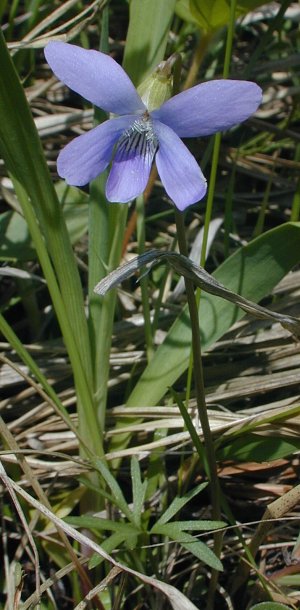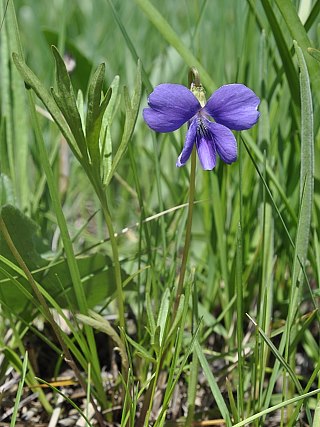 Description:
This perennial plant is about 3-6" tall. It consists of a
rosette of basal leaves, from which one or more flowering stems may
emerge that are somewhat taller. The basal leaves have a deeply lobed
palmate structure, and are rather fan-shaped in appearance. They are up
to 1" across and have petioles up to 1" long. The flowering stems are
more or less erect, but curve abruptly downward where the flowers or
buds occur. These flowers are about ¾" across and quite similar in
appearance to other violets. They have 5 petals that are blue-violet or
pale blue-violet, and 5 green sepals that are long and pointed, but
remain behind the petals. The two upper petals are more or less
rounded, but sometimes they are rather elongated. The lower side petals
have white hairy beards at the throat of the flower. At the base of the
lower center petal is a patch of white with fine lines of purple that
function as nectar guides to visiting insects. The Prairie Violet
usually blooms from mid- to late-spring, but it can also bloom during
the fall under favorable conditions. There is no noticeable floral
scent. During the summer months, inconspicuous cleistogamous flowers
mature into seedheads that are brown and triangular-shaped. These
release little brown seeds by mechanical ejection, which can fall to
the ground several inches away from the mother plant. The root system
is fibrous, and can form rhizomes.
Description:
This perennial plant is about 3-6" tall. It consists of a
rosette of basal leaves, from which one or more flowering stems may
emerge that are somewhat taller. The basal leaves have a deeply lobed
palmate structure, and are rather fan-shaped in appearance. They are up
to 1" across and have petioles up to 1" long. The flowering stems are
more or less erect, but curve abruptly downward where the flowers or
buds occur. These flowers are about ¾" across and quite similar in
appearance to other violets. They have 5 petals that are blue-violet or
pale blue-violet, and 5 green sepals that are long and pointed, but
remain behind the petals. The two upper petals are more or less
rounded, but sometimes they are rather elongated. The lower side petals
have white hairy beards at the throat of the flower. At the base of the
lower center petal is a patch of white with fine lines of purple that
function as nectar guides to visiting insects. The Prairie Violet
usually blooms from mid- to late-spring, but it can also bloom during
the fall under favorable conditions. There is no noticeable floral
scent. During the summer months, inconspicuous cleistogamous flowers
mature into seedheads that are brown and triangular-shaped. These
release little brown seeds by mechanical ejection, which can fall to
the ground several inches away from the mother plant. The root system
is fibrous, and can form rhizomes.
Cultivation:
The preference is full sun and mesic conditions. Some shade from
grasses and other plants later in the year is normal and tolerated. The
soil should have the capacity to retain some moisture during summer dry
spells, preferrably with high organic content. This plant can be
difficult and short-lived if a site doesn't satisfy its requirements.
Range & Habitat:
The native Prairie Violet is an uncommon plant in the northern half of
Illinois,
and rare or absent in the southern half (see Distribution
Map). Habitats include mesic to slightly dry black soil
prairies, savannas, and loess hill prairies. It is not
normally encountered in disturbed or developed areas, but can be
considered an indicator plant of high quality prairie remnants.
Occasional wildfires are probably a beneficial management tool, as this
removes much of the brush and dead debris that can smother these little
plants.
Faunal Associations:
Little information about flower-visiting insects is available for this
species of violet, but similar violets attract Anthophorine bees, Mason
bees, Eucerine Miner bees (Synhalonia spp.),
Halictine bees, small butterflies, and Duskywing skippers (Erynnis
spp.). Syrphid flies also visit violets, but they feed on
stray pollen and are non-pollinating. Because these insect visitors are
uncommon during the spring, the Prairie Violet is capable of
self-fertilization, like many other violets. The caterpillars of
various Fritillary butterflies feed on this and other violets,
including Euptoicta claudia (Variegated
Fritillary), Speyeria cybele (Great Spangled
Fritillary), Speyeria aphrodite (Aphrodite
Fritillary), Speyeria idalia (Regal Fritillary), Speyeria
diane (Diana), and Boloria selene myrina
(Silver-Border Fritillary). The small size and early growth habit of
this plant provide some protection from mammalian herbiovres.

Photographic
Location:
One photograph was taken at Loda Cemetery Prairie in Iroquois County,
Illinois, while the other photograph was taken by Lisa Culp (Copyright
© 2010) at a nature preserve in Cook County, Illinois. In one of the
photographs, the
small deeply lobed leaves of the Prairie Violet are located toward the
bottom in the center, peeking out from dead leaves of grasses; the
larger leaves behind and directly underneath the flower are from
unrelated species of plants.
Comments:
The deeply lobed leaves of Prairie Violet are similar in appearance to
those of Viola pedata (Bird Foot's Violet), but the
latter doesn't have tufts of white hair at the throat of its flowers.
Also, the flowers of Bird's Foot Violet are slightly larger in size and
sometimes fragrant.